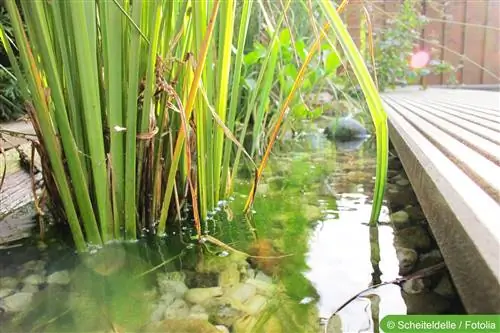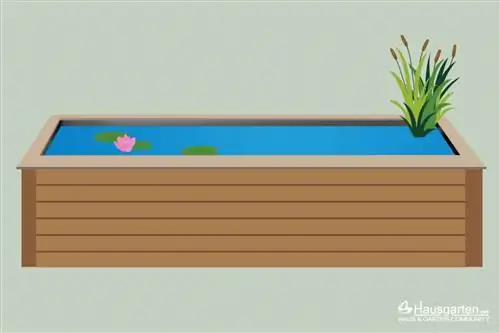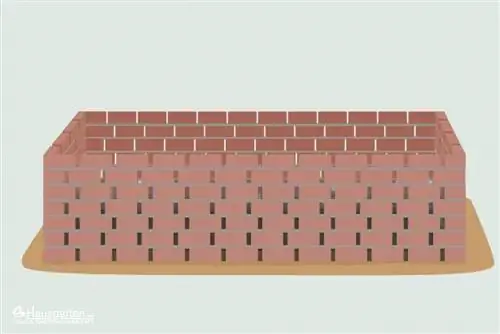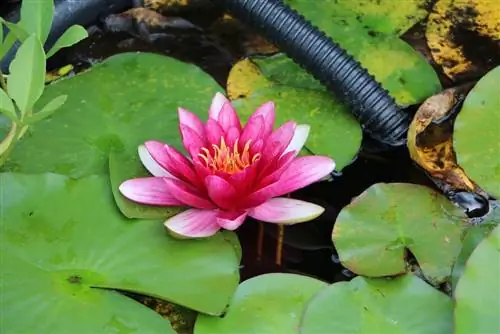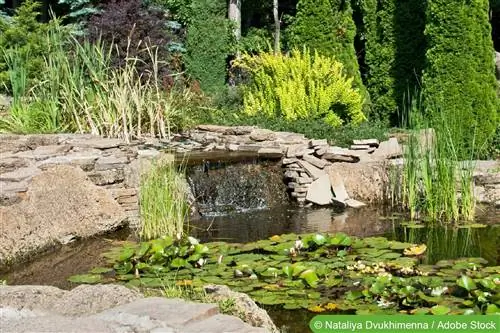- Author admin [email protected].
- Public 2023-12-17 03:39.
- Last modified 2025-01-24 12:45.
So-called terrace ponds are enjoying ever-increasing popularity for several reasons. One reason is that they are a very decorative addition to any terrace or balcony. What's more, they're incredibly easy to make, especially since you don't even have to dig a hole in the garden for them.
Additionally, they allow the greatest possible flexibility as they can be easily transported to another location, which is why terrace ponds are ideal for tenants. Terrace ponds are extremely flexible not only in terms of location, but also in terms of the seemingly limitless design options and the many ways in which they can be built.
Some types at a glance
Probably the easiest way to build your own patio pond is to convert a visually appealing container, such as an old wooden wine barrel or an elegant metal tub, into a pond by using it if necessary ordinary pond liner. Another variant is to buy a prefabricated pond tub and cover it decoratively. An inexpensive alternative to a “real” pond tub would be, for example, a commercially available one from the nearest hardware store. For example, wood paneling, natural stone or ordinary masonry are suitable for cladding.
Aside from covering it in the actual sense, you can of course also hide the pond tub behind so-called plant stones in which brightly colored flowers, ornamental grasses or other “decorative plants” are placed. Instead of a tub you can also use pond liner. However, it is advisable to first make the cladding and fill it with soil so that you get a hole of the desired size and shape. Another popular way to create a patio pond is to pour it out of concrete.
Construction instructions for concrete ponds
A variant of building a concrete pond for the terrace is to make formwork and fill it with liquid concrete. Although you can achieve an absolutely vertical pond border in this way, it is recommended to build the formwork so that the pond walls are slightly slanted. In this way, the ice that forms in the patio pond in winter can spread more easily, putting significantly less pressure on the patio pond. However, if the pond is to be emptied before each approaching winter anyway, the slope can of course be dispensed with. With regard to the formwork, it should also be noted that there are now special formwork materials available in well-stocked hardware stores with which not only straight-line but even artfully curved formwork is possible. Furthermore, it should be expressly pointed out that the formwork may only be removed when the concrete has completely hardened.
In another construction variant, like the pond variant, a pond lining is built with foil and filled with earth. You then dig a hole in the ground in the shape of the pond you want. The hole could now be filled directly with concrete. Instead, you can lay out a waterproof film in the hole in advance so that the pond definitely doesn't lose any water.
The third construction variant is, so to speak, a combination of the two previously mentioned variants, as it also involves filling a pre-made cladding with earth. However, the cladding and the soil only serve as formwork, which is why they are removed again after the concrete has completely hardened, so that in the end only the pure concrete pond is visible. Therefore, when making the mold, care must be taken to ensure that the finished concrete patio pond is stable so that it does not wobble too much or even fall over.
When curing the concrete, it is important to ensure that it is protected from direct sunlight and is constantly kept moist, otherwise it could crack. For example, you can moisten the material by spraying it regularly or dipping it in water from time to time and placing it back on the concrete. It should also be noted that concrete releases limescale during hardening and in the first few days afterwards. This lime can harm plants, which is why you should clean the patio pond thoroughly and seal the concrete before planting it and filling it with water.
For sealing, you can use special paints that are available from specialist retailers specifically for sealing concrete water reservoirs. When buying the paint, you should definitely make sure that it is free of toxins. This is especially true if it is assumed that children will play at the patio pond or pets will drink from it. Of course, it is advisable to use non-toxic paint just because of the environment in general and the pond plants in particular.
In addition to the pond paint mentioned, there are also so-called sealing slurries that can be used to seal concrete watertight. Apart from that, you can also use ordinary pond liner, which only needs to be laid out flush and wrinkle-free in the concrete pond. As an alternative to conventional pond liner, there are new liquid films that are applied to the concrete like thick paint and then only have to dry.
Patio pond ecosystem
All terrace pond variants mentioned here can be planted with aquatic plants. It is important that the location of the pond is chosen so that there are optimal conditions for all plants in terms of the prevailing lighting conditions and protection from excessive rain and strong winds. Instead of adapting the location of the pond to the plants, you can of course also buy plants that fit the desired location. When buying the plants, you should hold back a little at the beginning, as they will usually still grow and you can easily misjudge the size of the terrace pond. Theoretically, you could also keep fish in a terrace pond, but this is not recommended due to the small size of the pond.
Conclusion
As the construction recommendations for terrace ponds presented above show, it is extremely easy and, above all, inexpensive to enrich your terrace or balcony with an incredibly decorative attraction. Patio ponds are a wonderful alternative to a traditional pond, especially if you don't have space in the garden or no garden at all. If you would like to build the terrace pond completely and cheaply yourself, you can also proceed as follows:
- First build a platform out of disposable pallets so that the pond is at a comfortable height.
- You can get such disposable pallets in any hardware store and usually for free, because the hardware stores have to pay a lot of money to dispose of the disposable pallets and are happy about every buyer.
- Now you need wooden boards, which then have to be cut to the appropriate size that the terrace pond should have and screwed together.
- Styrofoam panels are needed for the internal lining of the pond, as they can be used to create insulation quite well. The panels are mounted on the inside of the conversion.
- Now the frost-proof pond liner is cut to the appropriate size and glued to the polystyrene cladding from the inside.
- You have to make sure that there are no cracks or small holes anywhere from which the water can escape.
- The corners should be double-glued with pond liner.
So that the pond is always well supplied with oxygen, you need a pond pump, which you can get from any gardening store or aquarium shop. Of course, the Internet also has many affordable offers, because a pond pump can sometimes be very expensive. Now you need a few more stones for decoration, maybe a pond lamp, pond plants and of course the water and the new residents.

